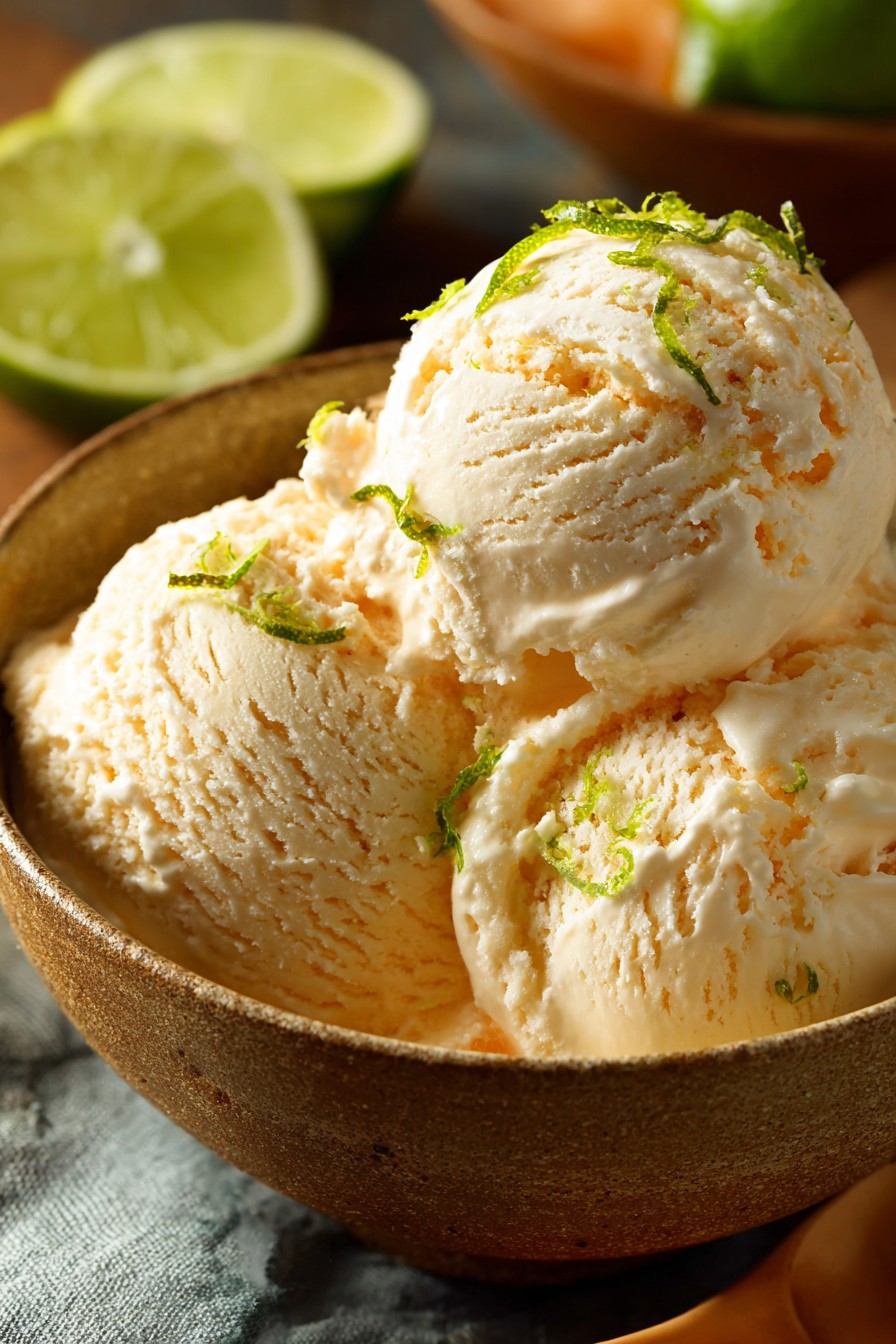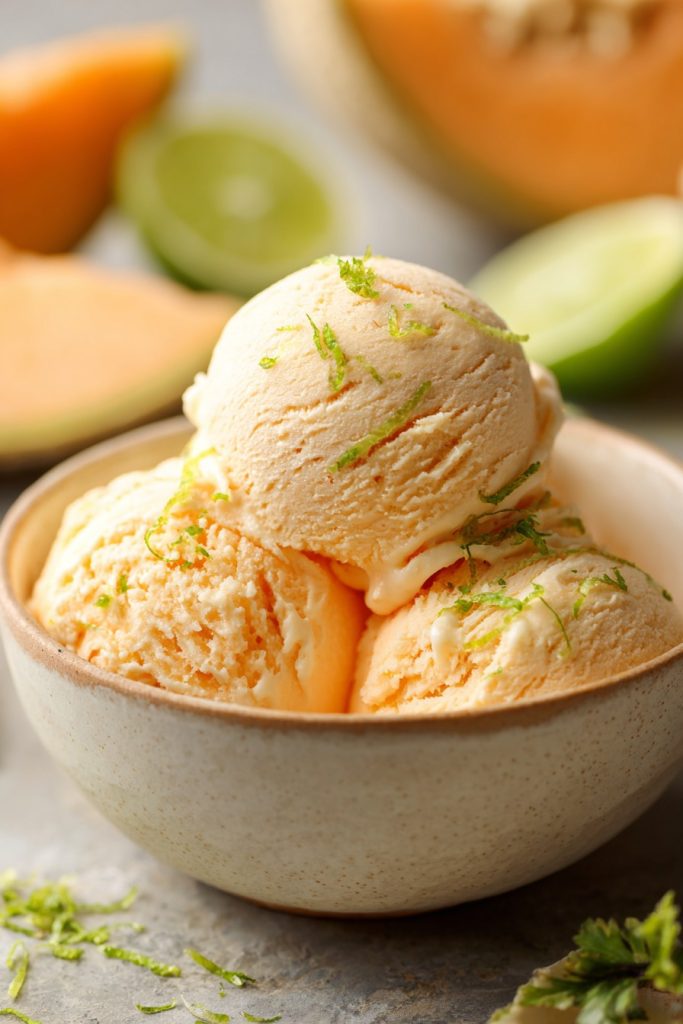From the sun-drenched fields of summer melons emerges an ice cream that captures the very essence of seasonal perfection. This sophisticated frozen dessert transforms the humble melon into an elegant culinary creation that balances natural sweetness with creamy indulgence, offering a refreshing alternative to traditional ice cream varieties while showcasing professional technique and ingredient harmony.
Why This Recipe Works
- The strategic combination of pureed melon flesh and heavy cream creates a perfect balance between fruit-forward freshness and rich dairy creaminess, ensuring neither element overpowers the other while maintaining optimal texture stability throughout the freezing process.
- Incorporating corn syrup alongside granulated sugar provides superior freeze-thaw stability and prevents ice crystal formation, resulting in a remarkably smooth mouthfeel that commercial stabilizers typically achieve but through natural ingredient synergy.
- Pre-chilling the base mixture to precisely 40°F before churning allows for faster freezing and smaller ice crystal development, producing that professional-quality creamy texture that distinguishes artisanal ice cream from amateur attempts.
- The addition of fresh lime juice and zest introduces bright acidity that cuts through the melon’s natural sweetness while enhancing its aromatic complexity, creating a more sophisticated flavor profile that evolves with each spoonful.
- Using an ice cream maker with built-in compressor technology ensures consistent temperature control during the churning process, which is critical for proper aeration and emulsion stability in fruit-based ice creams with high water content.
Ingredients
- 4 cups ripe cantaloupe melon, peeled, seeded, and diced into 1-inch cubes
- 1 ½ cups heavy cream (36% milk fat)
- 1 cup whole milk
- ¾ cup granulated sugar
- ¼ cup light corn syrup
- 6 large egg yolks
- 2 tablespoons freshly squeezed lime juice
- 1 tablespoon finely grated lime zest
- ½ teaspoon kosher salt
- 1 teaspoon pure vanilla extract
Equipment Needed
- Ice cream maker with compressor
- High-speed blender
- Fine-mesh strainer
- Digital instant-read thermometer
- Stainless steel bowl set
- Whisk
- Rubber spatula
- Airtight freezer containers
Instructions

Prepare the Melon Puree Base
Begin by processing the diced cantaloupe in a high-speed blender until completely smooth and free of fibrous texture, approximately 90 seconds on high speed. Transfer the puree to a fine-mesh strainer set over a medium bowl and gently press with a rubber spatula to separate the liquid from any remaining pulp, collecting approximately 2 ½ cups of strained melon juice. This straining step is crucial for achieving the silky texture characteristic of professional-grade ice cream, as it removes the insoluble fiber that can create graininess in the final product. Reserve both the liquid and the pulp separately, as the pulp can be utilized in other culinary applications if desired. The puree should exhibit a vibrant orange hue and possess a concentrated melon aroma indicating optimal ripeness and flavor development.
Create the Custard Foundation
Combine the heavy cream, whole milk, and half of the granulated sugar in a heavy-bottomed saucepan, heating over medium heat until the mixture reaches 170°F on a digital thermometer, stirring occasionally with a whisk to prevent scorching. Meanwhile, vigorously whisk the egg yolks with the remaining sugar and corn syrup in a separate bowl until the mixture becomes pale yellow and forms ribbon-like trails when the whisk is lifted, typically 3-4 minutes of continuous whisking. Temper the egg mixture by gradually ladling in about one cup of the hot cream mixture while whisking constantly, then slowly pour the tempered egg mixture back into the saucepan while continuing to whisk. Cook over medium-low heat, stirring constantly with a wooden spoon, until the custard thickens sufficiently to coat the back of the spoon and reaches 185°F, about 6-8 minutes.
Incorporate Flavor Components
Immediately remove the custard from heat and strain through a fine-mesh sieve into a clean bowl to ensure absolute smoothness, eliminating any potential cooked egg particles. Whisk in the strained melon puree, fresh lime juice, lime zest, kosher salt, and vanilla extract until fully incorporated. The acid from the lime juice will slightly thicken the mixture while balancing the sweetness profile. Professional tip: For optimal flavor development, create an ice bath by nesting the bowl containing the ice cream base within a larger bowl filled with ice water, stirring occasionally until the temperature drops to 40°F, which typically requires 25-30 minutes. This rapid cooling prevents bacterial growth and preserves the fresh melon flavor.
Churn to Perfection
Pour the thoroughly chilled base into your pre-cooled ice cream maker and churn according to manufacturer’s instructions until the mixture reaches a soft-serve consistency, which generally takes 25-35 minutes depending on your machine’s capacity and power. The ice cream should visibly thicken and increase in volume by approximately 30% due to proper aeration. Professional observation: When the paddle begins to leave distinct trails and the ice cream pulls away from the sides of the canister, it has reached the ideal churning endpoint. Avoid over-churning, as this can cause butterfat separation and compromise the final texture. The temperature should register between 21-23°F at completion.
Final Freezing and Service Preparation
Transfer the churned ice cream to airtight containers, pressing parchment paper directly onto the surface to prevent ice crystal formation, and freeze for a minimum of 4 hours or until firm, ideally at 0°F. For optimal scooping texture, temper the ice cream by transferring it to the refrigerator for 15-20 minutes before service. Professional serving suggestion: Use a heated ice cream scoop dipped in warm water between servings to create clean, elegant quenelles. The finished product should exhibit a smooth, creamy texture with distinct melon flavor notes balanced by citrus undertones and a pale orange coloration indicative of quality ingredients and proper technique.
Tips and Tricks
Selecting the optimal melon variety is paramount for achieving the finest flavor profile in your ice cream. Seek out cantaloupes that feel heavy for their size and exhibit a pronounced sweet aroma at the stem end, with a subtle give when pressed gently at the blossom end. The netting on the rind should be raised and well-defined, while the background color should transition from green to beige-yellow. For maximum sugar concentration, allow purchased melons to sit at room temperature for 1-2 days before preparation. When working with egg-based custards, temperature control remains the most critical factor for success. Use a digital thermometer throughout the process, particularly when tempering eggs and cooking the custard base. The ideal temperature range for custard cooking falls between 180-185°F, which pasteurizes the eggs while maintaining their emulsifying properties. If your custard accidentally curdles, immediately transfer it to a blender and process on high for 60 seconds to re-emulsify before straining. For those seeking dairy-free alternatives, coconut cream can substitute for heavy cream with excellent results, though the freezing characteristics will differ slightly. When using an ice cream maker without a built-in compressor, ensure the freezer bowl has been frozen for at least 24 hours at 0°F or below for optimal performance. The positioning of your freezer container during the final freeze stage significantly impacts texture consistency; place it in the coldest part of your freezer, typically at the back away from the door. For professional presentation, consider garnishing with candied melon rind or fresh mint sprigs, and always serve in chilled bowls to maintain optimal serving temperature throughout consumption.
Recipe Variations
- For a sophisticated herbal twist, infuse the cream mixture with ¼ cup fresh basil leaves during the heating process, straining them out before combining with the egg mixture. The basil’s aromatic compounds complement the melon’s sweetness while adding complexity that elevates the dessert to restaurant-quality status. This variation pairs exceptionally well with prosciutto-wrapped melon appetizers.
- Transform the base into a spiced melon ice cream by toasting 1 teaspoon of coriander seeds and ½ teaspoon of black peppercorns, then grinding them finely and steeping in the warm cream mixture for 30 minutes before straining. The warm spice notes create an intriguing contrast with the cool melon flavor, resulting in a more complex dessert suitable for autumn entertaining.
- Create a stunning swirled presentation by preparing a raspberry coulis separately and layering it with the churned ice cream during the final container transfer. The tart berry notes cut through the richness while providing visual appeal. For optimal swirl definition, avoid overmixing and aim for distinct ribbons of color throughout the frozen product.
- For an adult-oriented variation, incorporate 3 tablespoons of orange liqueur such as Grand Marnier or Cointreau during the final mixing stage before churning. The alcohol content will slightly lower the freezing point, resulting in a softer texture while adding sophisticated citrus notes that enhance the melon’s natural flavors. Reduce the milk by 2 tablespoons to account for the additional liquid.
- Experiment with different melon varieties such as honeydew or Galia melon to create unique flavor profiles. Honeydew will produce a paler green ice cream with subtler sweetness, while Galia melon offers tropical undertones that pair beautifully with coconut milk substitutions. Adjust sugar quantities based on the natural sweetness of your chosen melon variety.
Frequently Asked Questions
Can I make this recipe without an ice cream maker?
While an ice cream maker provides the optimal texture through continuous aeration during freezing, you can achieve respectable results using the freeze-and-stir method. Pour the chilled base into a shallow metal baking pan and freeze for 45 minutes until the edges begin to set. Remove and vigorously whisk with a fork or electric hand mixer to break up ice crystals, repeating this process every 30 minutes for 3-4 cycles until the desired consistency is reached. This manual method requires more attention but can produce acceptable texture, though it may be slightly denser than machine-churned versions. The key is rapid freezing and frequent agitation to prevent large ice crystal formation.
How long does homemade melon ice cream maintain optimal quality in the freezer?
When stored properly in airtight containers with parchment paper pressed directly on the surface, this ice cream maintains peak texture and flavor for approximately 2-3 weeks at 0°F. Beyond this timeframe, flavor degradation and ice crystal growth become more noticeable, though the product remains safe for consumption for up to 2 months. For longest preservation, avoid temperature fluctuations by placing containers in the back of the freezer rather than the door. The high fruit content makes this ice cream more susceptible to texture changes over time compared to custard-based varieties with lower water content.
What causes icy texture in fruit-based ice creams and how can I prevent it?
Icy texture typically results from either insufficient sugar content, inadequate fat percentage, or improper freezing technique. The natural water content in melon requires careful balancing with sugars (which act as antifreeze) and fats (which provide creaminess). Ensure your recipe maintains the proper ratio of approximately 20-25% sugar to total weight and 12-16% milk fat. Additionally, rapid freezing in an ice cream maker and proper storage techniques significantly reduce ice crystal size. Using corn syrup as partial sugar replacement helps bind water molecules, while thorough straining of the melon puree removes fibrous material that can nucleate ice formation.
Can I use frozen melon instead of fresh for this recipe?
While fresh melon provides superior flavor and texture, high-quality frozen melon can be substituted with some adjustments. Thaw frozen melon completely in a strainer set over a bowl to capture excess liquid, which should be reduced from the recipe to maintain proper consistency. Frozen melon may have slightly muted flavor, so consider increasing the quantity by 10-15% and adding a small amount of melon extract if available. The freezing process breaks down cell structure, resulting in a softer texture that may require additional straining to remove excess water. For best results, use individually quick frozen (IQF) melon rather than block-frozen varieties.
Why did my ice cream develop a grainy or sandy texture?
A grainy texture typically indicates either lactose crystallization or ice crystal formation due to temperature fluctuations during storage. Lactose crystallization occurs when the milk solids aren’t properly dissolved during the cooking process, so ensure you’re heating the custard to the specified temperature and whisking continuously. For ice crystal issues, maintain consistent freezer temperature and avoid repeatedly removing the container from the freezer. Another potential cause is undissolved sugar—make sure to whisk the sugar thoroughly into the egg mixture until completely dissolved before tempering. Using superfine sugar can help prevent this issue, as it dissolves more readily than standard granulated sugar.
Summary
This sophisticated melon ice cream showcases professional technique through precise temperature control, proper emulsification, and balanced flavor development. The result is a refreshing frozen dessert that captures summer’s essence while demonstrating culinary expertise through its creamy texture and complex flavor profile.
Melon Ice Cream
6
servings45
minutes15
minutesIngredients
Instructions
- 1 Puree diced cantaloupe in blender until smooth, then strain through fine-mesh sieve to remove pulp, collecting 2 ½ cups liquid.
- 2 Heat cream, milk, and half the sugar to 170°F, then temper with egg yolks whisked with remaining sugar and corn syrup.
- 3 Cook custard to 185°F until thickened, strain, then whisk in melon puree, lime juice, zest, salt, and vanilla.
- 4 Chill mixture to 40°F in ice bath, then churn in ice cream maker until soft-serve consistency (25-35 minutes).
- 5 Transfer to airtight containers, press parchment on surface, and freeze 4+ hours until firm before serving.



